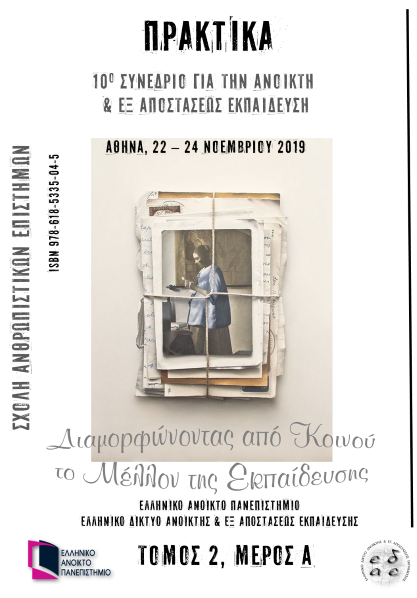Graphic-text integration in distance education science textbooks / Αλληλεπίδραση εικόνας-κειμένου σε εγχειρίδια φυσικών επιστημών εξ αποστάσεως εκπαίδευσης
Περίληψη
Considering the fact that (a) textbooks determine largely what is taught and learned in science classrooms, (b) science textbooks tend to rely heavily on illustrations, (c) the role of textbook in distance education may be even more important than in conventional classroom-centered education, and (d) there is little information available about the graphical demands of science textbooks used in distance education, this paper reports on exploring the graphics included in science textbooks used in a distance learning undergraduate course. More specifically, we investigated the graphics included in three textbooks (chemistry, biology and physics) used in the ‘Studies in Natural Sciences’ course offered by the Hellenic Open University. Drawing on the Graphical Analysis Protocol (GAP), we coded the 268 graphics identified in mutually exclusive categories concerning text-graphic integration – i.e. (a) level of contiguity between graphics and text, (b) extent of in-text reference to graphics, and (c) captions’ function regarding text-graphics connection. The analysis of results suggests that (i) the majority of graphics are contiguous with the relevant text in the biology and physics textbooks but this is not the case for the chemistry textbook, (ii) the majority of graphics are referenced in the text of all three textbooks, and (iii) the majority of graphics in all textbooks have captions that are mostly used to (a) describe the graphics included in the chemistry textbook, (b) identify what is shown in the graphics included in the physics and biology textbooks.
Λαμβάνοντας υπόψη το γεγονός ότι (α) τα σχολικά εγχειρίδια καθορίζουν σε μεγάλο βαθμό το περιεχόμενο της διδασκαλίας των φυσικών επιστημών, (β) τα σχολικά εγχειρίδια φυσικών επιστημών τείνουν να βασίζονται σε μεγάλο βαθμό στην εικονογράφησή τους, (γ) ο ρόλος των σχολικών εγχειριδίων στην εξ αποστάσεως εκπαίδευση μπορεί να είναι πιο σημαντικός από ότι στη συμβατική εκπαίδευση, και (δ) υπάρχουν λίγες διαθέσιμες πληροφορίες σχετικά με τις απαιτήσεις της εικονογράφησης των εγχειριδίων φυσικών επιστημών που χρησιμοποιούνται στην εξ αποστάσεως εκπαίδευση, η παρούσα εργασία αναφέρεται στη διερεύνηση της εικονογράφησης των εγχειριδίων φυσικών επιστημών που χρησιμοποιούνται σε μαθήματα εξ αποστάσεως εκπαίδευσης. Πιο συγκεκριμένα, διερευνήσαμε τις εικόνες τριών εγχειριδίων (χημείας, βιολογίας και φυσικής) που χρησιμοποιούνται στο μάθημα «Σπουδές στις Φυσικές Επιστήμες» που προσφέρει το Ελληνικό Ανοιχτό Πανεπιστήμιο. Με βάση το πρωτόκολλο Graphical Analysis Protocol (GAP), κωδικοποιήσαμε τις 268 εικόνες που ανιχνεύθηκαν σε αμοιβαία αποκλειόμενες κατηγορίες που αφορούσαν την αλληλεπίδραση εικόνων και κειμένου – δηλαδή (α) το επίπεδο συνοχής μεταξύ εικόνων και κειμένου, (β) την ύπαρξη αναφορών στο κείμενο για τις αντίστοιχες εικόνες, και (γ) τη λειτουργία των λεζάντων σχετικά με τη σύνδεση εικόνων και κειμένου. Η ανάλυση των αποτελεσμάτων δείχνει πως (1) η πλειοψηφία των εικόνων έχει καλή συνοχή με το κείμενο στα εγχειρίδια βιολογίας και φυσικής, αλλά αυτό δεν ισχύει για το εγχειρίδιο χημείας, (2) για την πλειοψηφία των εικόνων και στα τρία εγχειρίδια υπάρχουν αναφορές στο κείμενο, και (3) η πλειοψηφία των εικόνων και στα τρία εγχειρίδια έχουν λεζάντες που χρησιμοποιούνται κυρίως για (α) να περιγράψουν αυτό που εικονίζεται (εγχειρίδιο χημείας), (β) να προσδιορίσουν αυτό που εικονίζεται (εγχειρίδια φυσικής και βιολογίας).
Λεπτομέρειες άρθρου
- Τεύχος
- Τόμ. 10 Αρ. 2Α (2019)
- Ενότητα
- Άρθρα



